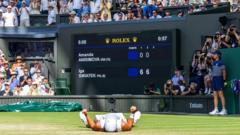Can You Believe Woakes Had Two Wickets Overturned in One Over?

England vs. India Third Test: A Dramatic Day at Lord's
In a thrilling encounter at Lord's, the third Test match between England and India showcased a blend of skill, strategy, and a dash of drama. The spotlight shone brightly on England's Chris Woakes, whose remarkable bowling performance nearly yielded two crucial wickets in the same over. However, both dismissals were overturned upon review, much to the delight of the vocal Indian fans present. This article delves into the day's events, the implications of the reviews, and what this means for both teams moving forward in the series.
The Context of the Series
The third Test is a pivotal point in the series, with both teams vying for supremacy. England and India have a storied rivalry, and every match brings with it a plethora of emotions and expectations. The stakes are high, and every run and wicket counts significantly in the broader context of the series.
England's Performance So Far
As the host nation, England came into the match with a strong lineup, bolstered by the experience of seasoned players like Chris Woakes. The conditions at Lord's, traditionally favoring seam and swing bowlers, played into England's hands. However, the pressure was on them to capitalize on home advantage and deliver a convincing performance against a formidable Indian side.
India's Response
On the other hand, India has shown resilience and determination throughout the series. With a blend of young talent and experienced campaigners, the Indian team has been a tough competitor. Their fans, known for their unwavering support, filled the stands at Lord's, creating an electrifying atmosphere that undoubtedly influenced both teams.
The Dramatic Over
The highlight of the day came when Chris Woakes bowled a fiery over that left Indian batsman Akash Deep in a precarious position. Woakes managed to trap Deep leg before wicket, a moment that had the England players celebrating in anticipation of a key breakthrough. However, cricket is a game of uncertainties, and the drama unfolded as the decision was reviewed.
First LBW Appeal
Upon the first appeal, the on-field umpire raised his finger, signaling an LBW. The England players erupted in joy, believing they had struck gold. However, the review process revealed that the ball had pitched outside leg stump, leading to the decision being overturned. This moment was pivotal; it not only maintained Deep's wicket but also shifted momentum back towards India.
Second LBW Appeal
Incredibly, Woakes repeated the feat within the same over. Again, Deep was trapped in front, and once more, England felt that victory was within their grasp. Yet, as cricket often teaches us, nothing is guaranteed. The review process was initiated again, and this time, the ball was shown to be clipping the bails, leading to another reversal. The crowd, predominantly Indian supporters, erupted in cheers, celebrating the resilience of their player and the dramatic turn of events.
The Impact of Technology in Cricket
The use of technology in cricket, particularly the Decision Review System (DRS), has revolutionized how the game is played. While it brings precision and accuracy to contentious decisions, it also adds layers of pressure on players and umpires alike. The overturning of decisions can shift momentum dramatically, influencing the psychological state of both teams.
Advantages of DRS
- Accuracy: DRS provides a more precise analysis of dismissals, reducing human error.
- Fairness: Players have the opportunity to challenge on-field decisions, promoting a fairer playing environment.
- Strategic Play: Teams can use reviews strategically, adding an element of psychological warfare.
Challenges of DRS
- Pressure on Players: Players must maintain composure, knowing their decisions can be overturned.
- Umpire's Reputation: Frequent reviews can lead to scrutiny of umpires’ decision-making abilities.
- Game Flow Disruption: The review process can interrupt the rhythm of the game.
What’s Next for Both Teams?
With the third Test still in progress, both teams have much to play for. England will look to capitalize on their bowling strengths and put pressure on the Indian batting lineup. Conversely, India aims to build on their batting resilience and exploit any weaknesses in the English bowling attack.
England's Strategy Going Forward
For England to gain the upper hand, the following strategies could be pivotal:
- Maintain Bowling Pressure: Continuing to bowl tightly will be crucial in breaking partnerships.
- Field Placement: Optimizing field placements to capitalize on the conditions will enhance wicket-taking opportunities.
- Batting Depth: Ensuring that the batting lineup supports the bowlers with substantial runs will be essential.
India's Game Plan
India, on the other hand, will focus on the following:
- Building Partnerships: Establishing strong partnerships is vital to maintaining a healthy run rate.
- Countering Pace: Batsmen need to adapt their techniques against England’s pace attack.
- Utilizing Reviews Wisely: Making strategic use of reviews can turn the tide in their favor.
Conclusion
The third Test between England and India at Lord's has unfolded with the intensity and excitement that fans have come to expect from this historic rivalry. The dramatic events surrounding Chris Woakes’ two LBW appeals against Akash Deep encapsulate the unpredictability and thrill that cricket offers. As both teams strategize their next moves, the match serves as a reminder of cricket's rich tapestry, where every ball can change the course of the game.
As the day progresses, fans will be on the edge of their seats, wondering what other surprises await. Will England capitalize on their home advantage, or will India demonstrate their resilience and fight back? Only time will tell.
FAQs
What is the Decision Review System (DRS) in cricket?
The Decision Review System (DRS) is a technology-based system used in cricket to assist umpires in making accurate decisions regarding dismissals. It includes tools like ball-tracking and UltraEdge to review on-field calls.
How does LBW work in cricket?
Leg Before Wicket (LBW) is a mode of dismissal in cricket where a batsman can be given out if the ball hits their leg (or pads) before hitting the bat, and the ball would have gone on to hit the stumps.
Why is the third Test significant in a series?
The third Test often serves as a crucial juncture in a series, especially if the teams are closely matched. It can determine the momentum for the remainder of the series and has the potential to sway the overall outcome.
As the action unfolds, who do you think will emerge victorious in this thrilling contest at Lord's? #Cricket #EngvInd #TestMatch
Published: 2025-07-12 17:48:10 | Category: sport



